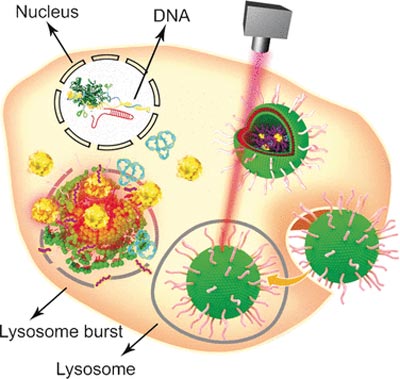Multifunctional Platform for the Delivery of Gene Therapeutics

Gene editing is one of the hottest topics in cancer research. A Chinese research team has now developed a gold-nanoparticle-based multifunctional vehicle to transport the “gene scissors” to the tumor cell genome. As the authors report in the journal Angewandte Chemie, their nonviral transport and release platform of gene-editing systems has the additional advantage of combining hyperthermal cancer therapy with genetic modification.
Since its discovery in 2002, the bacterial antiviral defense strategy CRISPR-Cas9 has emerged as one of the most popular genome engineering approaches with wide applications in the fields of molecular biology and biomedicine. Using the CRISPR-Cas9 system, a target gene can be edited, knocked out, or inserted in eukaryotic cells in a relatively simple and convenient manner.
However, one of its weak points is its sheer size, which demands the use of specific nonviral vehicles to deliver the large plasmid to the nucleus. Combining established lipid formulations with gold nanoparticles, Wenfu Zheng and his colleagues from the National Center for NanoScience and Technology, Beijing, China, in cooperation with medical scientists in Japan and China, have found and tested a multifunctional tool based on simple components that effectively delivers and releases the CRISPR-Cas9 system into tumors.
Laser irradiation was used to disassemble the lipid–nanogold vehicle after its entry in the tumor cells and enable the CRISPR-Cas9 gene editing. The knockout of the targeted gene then led to apoptosis and tumor growth inhibition.
Gold nanoparticles are especially attractive carriers for various biological molecules because of their easy modification, stability, and light-irradiation response. To convert them into a versatile biological transport and delivery vehicle, the scientists first attached Tat peptides—which facilitate the crossing of the cell nucleus membrane—to gold nanoparticles.
Then, the CRISPR-Cas9 plasmid containing the RNA targeting the Plk-1 gene—the knockout of which would severely impair tumor cell function—was attached to the Tat peptides through electrostatic interactions so that they would release their load right after entering the nucleus. Finally, the nanoparticular system was coated with a formulation of lipids to improve cellular uptake.
To test the system, cells and tumor-bearing mice were both administrated with the CRISPR-Cas9-plasmid-carrying nanogold vehicle, and the release of the gene-editing machine was triggered by a laser. “In this study, light irradiation caused the release of the Tat peptide from the gold nanoparticles in a time- and laser-intensity-dependent manner,” the authors explained.
Other approaches are also possible as they pointed out: as the gold nanoparticles heat up upon irradiation, they could serve as thermotherapeutic agents themselves. In summary, this relatively simple design entailing gold nanoparticles, peptides, and lipids assembled into a sophisticated multifunctional carrier/release system could serve as a multifunctional delivery platform for various aspects of gene therapy.
Dr. Wenfu Zheng is an Associate Professor in Nanomedicine at the National Center for NanoScience and Technology, Beijing, China. His research interests span nanomaterials for drug delivery, organs-on-a-chip, and tissue engineering.
Author: Wenfu Zheng, National Center for Nanoscience and Technology (China), mailto:zhengwf@nanoctr.cn
Title: Thermo-triggered Release of CRISPR-Cas9 System by Lipid-Encapsulated Gold Nanoparticles for Tumor Therapy
Angewandte Chemie International Edition
Permalink to the original article: https://doi.org/10.1002/anie.201708689 – Please use in your news piece to make sure altmetric.com picks it up and a link to your piece is shown on the journal's website.
Copy free of charge. We would appreciate a transcript of your article or a reference to it.
The original article is available from our online pressroom at http://pressroom.angewandte.org.
Contact: Editorial office: angewandte@wiley-vch.de
Angewandte Chemie is a journal of the Gesellschaft Deutscher Chemiker (German Chemical Society, GDCh) and is published by Wiley-VCH. It is one of the prime chemistry journals in the world.
Angewandte Chemie International Edition, Postfach 101161, 69451 Weinheim, Germany.
Media Contact
More Information:
http://www.gdch.de/All latest news from the category: Life Sciences and Chemistry
Articles and reports from the Life Sciences and chemistry area deal with applied and basic research into modern biology, chemistry and human medicine.
Valuable information can be found on a range of life sciences fields including bacteriology, biochemistry, bionics, bioinformatics, biophysics, biotechnology, genetics, geobotany, human biology, marine biology, microbiology, molecular biology, cellular biology, zoology, bioinorganic chemistry, microchemistry and environmental chemistry.
Newest articles

Silicon Carbide Innovation Alliance to drive industrial-scale semiconductor work
Known for its ability to withstand extreme environments and high voltages, silicon carbide (SiC) is a semiconducting material made up of silicon and carbon atoms arranged into crystals that is…

New SPECT/CT technique shows impressive biomarker identification
…offers increased access for prostate cancer patients. A novel SPECT/CT acquisition method can accurately detect radiopharmaceutical biodistribution in a convenient manner for prostate cancer patients, opening the door for more…

How 3D printers can give robots a soft touch
Soft skin coverings and touch sensors have emerged as a promising feature for robots that are both safer and more intuitive for human interaction, but they are expensive and difficult…





















